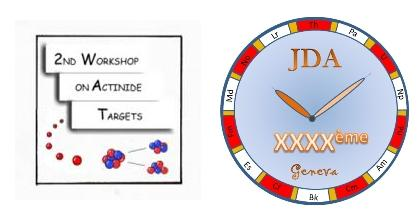Speaker
T. Klimczuk
Description
Crystal structure and physical properties of NpRh2Sn,
a new Np-based ternary compound
T. Klimczuk,1,2 J.-C. Griveau,1 R. Eloirdi,1 E. Colineau1, and R. Caciuffo1
1 European Commission, Joint Research Center, Institute for Transuranium Elements, Postfach 2340, Karlsruhe, D-76125 Germany, e-mail: Tomasz.Klimczuk@ec.europa.eu
2 Faculty of Applied Physics and Mathematics, Gdansk University of Technology,
Narutowicza 11/12, 80-233 Gdansk, Poland
The large family of the ternary actinide compounds AnT2M, where An is an actinide element, T is a transition element, and M is a metalloid, forms mainly in the orthorhombic crystal structure (Pnma, s.g. 62). The uranium based alloys (UT2M) have attracted considerable attention due to a wide range of physical properties, which originates from the sensitive nature of the uranium 5f-electrons. Very few compounds with An other than uranium have been reported, and most of them contain palladium as the transition element.
Here, we will present the crystal structure and physical properties of a new intermetallic NpRh2Sn compound, which is the first member of the AnRh2M family.
A sample with nominal stoichiometry NpRh2Sn was prepared by arc-melting under argon atmosphere. The as-cast piece was studied by x-ray powder diffraction and the result is presented in Figure 1. The GSAS package was used for Rietveld structure refinement [1,2]. Refined lattice parameters, An-An distance for NpRh2Sn, and few other members of AnT2M, are summarized in Table 1.
Fig. 1. Room temperature x-ray diffraction pattern of NpRh2Sn. (+) represent experimental data, black and red ticks indicate Bragg peak positions for NpRh2Sn and NpO2 respectively. The refinement and difference are shown as solid lines. The crystal structure of NpRh2Sn is presented in the inset.
a (Å) b (Å) c (Å) d An-An (Å) TN (K) CW (K)
NpRh2Sn 9.7300(6) 4.4278(3) 6.9115(5) 3.984 34 -29
NpPd2Sn [3] 10.004(3) 4.535(2) 6.961(1) *) 15 -80
PuPd2Sn [4] 10.053(9) 4.502(4) 7.065(6) *) 11 -30
UPd2Sn [5] 9.9415(4) 4.6050(2) 6.8633(3) 4.182 --- -100
Table 1. Refined lattice parameters, distance between actinide atoms (dAn-An), Néel temperature (TN), and paramagnetic Curie-Weiss temperature (CW), for selected members of AnT2Sn family. *) – due to the lack of information about the refined atomic positions for NpPd2Sn and PuPd2Sn, the dAn-An can not be calculated for these two compounds, but some information can be deduced by comparing b lattice parameter.
In Figure 2 we show the temperature dependence of inverse susceptibility (a) and specific heat (b) of NpRh2Sn. The Curie-Weiss fit of the data above 75K (red solid line) gives a Curie-Weiss temperature CW= -29K, and an effective magnetic moment eff2.42B. This is close to the expected value for Np+3 (2.68B). This measurement indicates an antiferromagnetic anomaly at TN = 34K. At the same temperature region a slight change of slope is observed on the specific heat curve CP(T). Marginal evidence of a specific heat anomaly was reported also for UPd2Sn, as discussed in Ref. [5].
Fig. 2. a) The temperature dependence of the inverse magnetic susceptibility (-1) and b) specific heat (CP) of NpRh2Sn. The straight, red line through the data is the fit by the Curie-Weiss law.
To summarize, we have synthesized and studied a new Np-based ternary NpRh2Sn compound. Its properties are similar to NpPd2Sn, although a shorter Np-Np distance causes an increase of the Néel temperature. NpRh2Sn is a rare representative of heavy-fermion systems amidst Np- intermetallics.
References
[1] B. H. Toby, J. Appl. Cryst. 34, 210 (2001).
[2] A. C. Larson and R. B. Von Dreele, Los Alamos National Laboratory Report LAUR, 86 (2000).
[3] D. Kaczorowski et al., Physica B 359-361, 1102-1104 (2005).
[4] K. Gofryk et al., Phys. Rev. B 77, 014431 (2008).
[5] I. Maksimov et al., Phys. Rev. B 67, 104405 (2003).
Aknowldegments:
Np metal required for the fabrication of the compound was made available through a loan agreement between Lawrence Livermore National Laboratory and ITU, in the frame of a collaboration involving Lawrence Livermore National Laboratory, Los Alamos National Laboratory, and the US Department of Energy.
T.K. acknowledges the European Commission for financial support.




